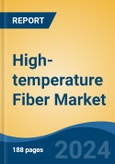Industrial is the fastest growing segment, North America is the largest market globally
Speak directly to the analyst to clarify any post sales queries you may have.
10% Free customizationThis report comes with 10% free customization, enabling you to add data that meets your specific business needs.
Key Market Drivers
Increased demand from the aerospace and defense sectors is a pivotal driver for the high-temperature fiber market, stemming from the continuous need for materials that offer both lightweight properties and superior thermal resistance. Modern aircraft and defense systems require components that can withstand extreme operational temperatures while contributing to fuel efficiency and enhanced performance. High-temperature fibers, such as advanced carbon fibers and ceramic matrix composites, are integral to critical applications like engine components, exhaust systems, and structural elements. These materials enable engineers to design lighter airframes and more efficient propulsion units, directly impacting operational costs and capabilities.Key Market Challenges
The inherently high production costs represent a significant challenge for the global high-temperature fiber market. The specialized manufacturing processes, which involve complex techniques and substantial energy consumption, directly contribute to elevated per-unit costs. Furthermore, the limited availability of certain critical raw materials, often requiring intricate extraction and purification, exacerbates these expenses. This elevated cost structure results in higher selling prices for high-temperature fibers, potentially limiting their competitiveness against alternative materials and restricting their widespread adoption, especially in cost-sensitive applications.Key Market Trends
The growing development of sustainable high-temperature fibers marks a significant market trend, driven by increasing environmental consciousness and regulatory pressures for eco-friendly material solutions. This involves innovating new fiber compositions, enhancing recyclability, and reducing the carbon footprint of production processes. In April 2024, UBE Corporation introduced new composite products incorporating recycled carbon fiber into various nylons, targeting automotive and sports applications to decrease energy consumption and lower greenhouse gas emissions. Such initiatives are pivotal as industries seek to align with global sustainability goals, fostering a circular economy even for high-performance materials.Key Market Players Profiled:
- DuPont de Nemours, Inc.
- Morgan Advanced Materials plc
- Toyobo Co. Ltd.
- Teijin Limited
- Toray Industries, Inc.
- Kolon Industries, Inc.
- Kamenny Vek
- Tayho Advanced Materials Group Co Ltd.
- Corning Incorporated
- S.I.C.C.E.T. S.r.l
Report Scope:
In this report, the Global High-temperature Fiber Market has been segmented into the following categories:By Fiber Type:
- Aramid
- Ceramic
- Other
By Application:
- Security & Protection
- Automotive
- Aerospace
- Industrial
- Electrical & Electronics
- Others
By Region:
- North America
- Europe
- South America
- Middle East & Africa
- Asia Pacific
Competitive Landscape
Company Profiles: Detailed analysis of the major companies present in the Global High-temperature Fiber Market.Available Customizations:
With the given market data, the publisher offers customizations according to a company's specific needs. The following customization options are available for the report:- Detailed analysis and profiling of additional market players (up to five).
This product will be delivered within 1-3 business days.
Table of Contents
Companies Mentioned
- DuPont de Nemours, Inc.
- Morgan Advanced Materials plc
- Toyobo Co. Ltd.
- Teijin Limited
- Toray Industries, Inc.
- Kolon Industries, Inc.
- Kamenny Vek
- Tayho Advanced Materials Group Co Ltd.
- Corning Incorporated
- S.I.C.C.E.T. S.r.l
Table Information
| Report Attribute | Details |
|---|---|
| No. of Pages | 188 |
| Published | November 2025 |
| Forecast Period | 2024 - 2030 |
| Estimated Market Value ( USD | $ 10.02 Billion |
| Forecasted Market Value ( USD | $ 16.8 Billion |
| Compound Annual Growth Rate | 9.0% |
| Regions Covered | Global |
| No. of Companies Mentioned | 10 |









